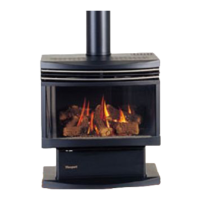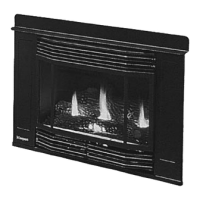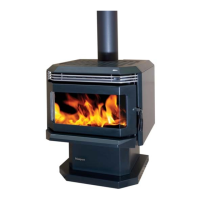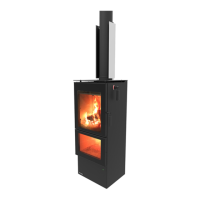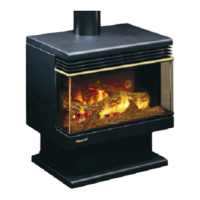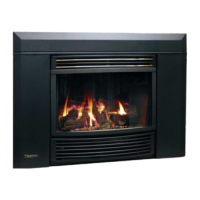Masport PG36-3 Gas Inbuilt 19
INSTALLATION
PG36-NG3 System Data
For 0 to 4500 feet altitude
Burner Inlet Orifice Sizes: #37( 2.65mm)
Max. Input Rating 33 mj
Min. Input Rating 20 mj
Supply Pressure min.1.13 kPa
Manifold Pressure
(High) 0.9 kPa
Electrical: 240 V A.C. System.
Circulation Fan: variable speed 130 CFM.
Log Set: Ceramic fibre, 7 per set.
Flue System: Simpson Dura-Vent Direct
Flue System or Masport Direct
Flue System (Flex)
PG36-LPG3 System Data
For 0 to 4500 feet altitude
Burner Inlet Orifice Sizes: #52 (1.61mm)
Max. Input Rating 31 mj
Min. Input Rating 18 mj
Supply Pressure min 2.75 kPa
Manifold Pressure
(High) 2.6 kPa
Electrical: 240 V A.C. System.
Circulation Fan: variable speed 130 CFM.
Log Set: Ceramic fibre, 7 per set.
Flue System: Simpson Dura-Vent Co Axial
Flue System
AERATION
ADJUSTMENT
The air shutter can be adjusted by moving the
adjusting wire up or down. The wire is ac-
cessed through the bottom louvre opening.
Open the air shutter for a blue flame or close for
a yellower flame. The burner aeration is factory
set but may need adjusting due to either the local
gas supply or altitude. This adjustment is per-
formed by the gas fitter.
Minimum Air Shutter Opening:
8 mm NG
Full Open LPG
CAUTION: Carbon will be produced if air
shutter is closed too much.
Note: Any damage due to carboning re-
sulting from improperly setting the
aeration controls is NOT covered
under warranty.
Closed - Tall yellow
Open - Short Blue
GAS CONNECTION
The gas line should be rigid pipe. Copper may
also be used if approved by AG 601.
The gas connection at the valve is 1/2 male. For
minimum and maximum supply pressure see the
System Data Table.
GAS PIPE PRESSURE
TESTING
The appliance must be isolated from the gas
supply piping system by closing its individual
manual shut-off valve during any pressure
testing of the gas supply piping system at test
pressures equal to or less than 1/2 psig. (3.45
kPa). Disconnect piping from valve at pres-
sures over 3.45 kPa (14" w.c.).
The manifold pressure is controlled by a regu-
lator built into the gas control, and should be
checked at the pressure test point.
Note: To properly check gas pressure,
both inlet and manifold pressures
should be checked using the valve
pressure ports on the valve.
1) Make sure the valve is in the "OFF" position.
2) Loosen the "IN" (# 3) and/or "OUT" (# 4)
pressure tap(s), turning counterclockwise
with a 1/8" wide flat screwdriver.
3) Attach manometer to "IN" and/or "OUT" pres-
sure tap(s) using a 5/16" (8mm) ID hose.
4) Seal and or check the pilot outlet (# 8)
5) The pressure check should be carried out
with the unit burning and the setting should
be within the limits specified on the safety
label.
6) When finished reading manometer, turn off
the gas valve, disconnect the hose and
tighten the screw (clockwise) with a 1/8"
flat screwdriver. Screw should be snug,
but do not over tighten.
S.I.T. Valve Description
1) On-Off Solenoid Valve EV1
2) On-Off Solenoid Valve EV2
3) Inlet Pressure Test Point
4) Outlet Pressure Test Point
5) Connection for Pressure Regulator/Com-
bustion Chamber Compensation
6) Pressure Regulator for Minimum and Max-
imum Outlet Pressure
7) Gas Outlet Pressure Electric Modulator
8) Pilot Outlet
9) Main Gas Outlet
10)Side Outlet

